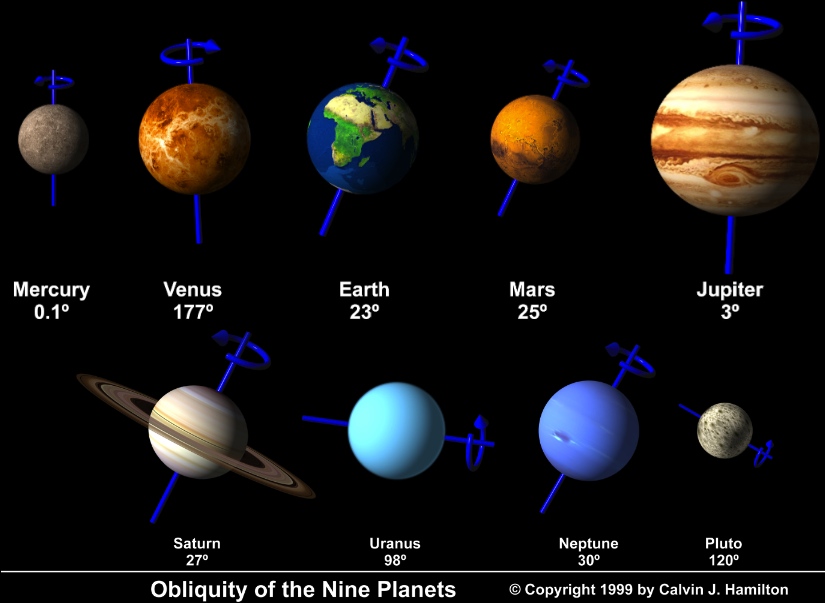Home > Sections > Specials > Earth's Rotation
Earth's Rotation

Keywords
Earth, rotation, axis, axial procession, wobble, spinning, equator, poles, 23 degrees, seasons, tidal lock.
Introduction
We all know that the Earth spins. It spins on an axis, and we have night and day times. We base time on a constant that involves the rotation of the Earth. But what does this actually mean from a scientific point of view?
Earth's Tilt
Earth sits on an axis that is tilted. To put this into perspective, the planet sits 23° off an imaginary line that astronomers use to show how a planet rotates. This imaginary line is called the axis.
All planets in our solar system have either a slight tilt, or quite an extreme tilt. Mercury has a tilt of 0.1°, whereas Uranus has a tilt of 98°. This means that Uranus lays on it's side with the axis of North and South going "across" the planet, instead of from top to bottom.
Earth has a tilt between 22.1 and 24.5°, which means it changes through the year. This change is one of the causes that makes our planet have seasons. This "wobble" is called axial procession.
Change of Seasons
Because of the tilt, making Earth orbit the Sun at an angle, we have seasons. Depending on the time of the year, depends on the season. Traditionally, each season has it's own set of weather patterns, including:
- Spring - typically a time where plants begin to grow and have mild weather.
- Summer - typically warm temperatures, and sometimes hot, sunny weather.
- Autumn - also known as Fall in the US, it is when trees and deciduous plants lose their leaves. Mixed weather during this time.
- Winter - usually cold, with wintery conditions such as snow and ice.
Interesting fact: due to the Earth's rotational bulge, the highest point on Earth is not Mount Everest, but Chimborazo, Ecuador.
Depending where you are in the world, depends on the type of weather we have, as well as how much daylight we are subjected to.
For example, in the UK, when it is winter, Australia (being on the opposite side of the planet) has it's summer. The same is true when the UK has it's summer; Australia has it's winter.
This also governs our garden. We eat a lot of organic materal, and in order to have that, we need to be able to have decent weather with which to grow it. You can't (without some sort of shelter) grow much during winter months that will enable us to eat. We need the warmth of the Sun to help it grow and yield anything for us.
This is all because of the tilt on the Earth.
What About the Rotation?
So much is placed upon the rotation of the Earth. Like I said earlier, we base our time on it. There are 86,400 seconds in a day. We commonly know this to be 24 hours, and a clock face will display either a 12-hour or 24-hour face, where time is recorded. We then use this to base around our daily lives.
This is all possible because of the rotation around the Sun by the planet. The rotation of the planet has changed over it's 4.6 billion years of being in the solar system.
The Earth's rotation is slowing down, and each day is actually slowing by up to 1.8 milliseconds per century (100 years!). Around 600 million years ago, a day would be around 21 hours.
Tidal effects are also governed by the Earth's rotation. Along with the presence of the Moon, the Sun also factors into this.
Here is a YouTube video from NG Science to explain Earth Rotation:
Rotation Speed
We know that, on average, the rotation speed is around 1,037.5646 miles per hour (1,669.8 km/h). This is based on being on the equator. If you were on the North Pole, it would be slower, due to it being at one of the axis poles.
A recent study in 2020 found that after many many years, the rotation of the Earth had stopped slowing down, and had started to speed up. The shortest 28 days occured in 2020.
End Note
So, what have we learnt? The Earth (and all the planets) sit on an axis that is like an imaginary line. The planet spins on this axis, and has seasons due to the position around the Sun. We have also learnt that we base lots of components on this rotation - time, what we can grow, when to grow it, and more.




 The Planets
The Planets